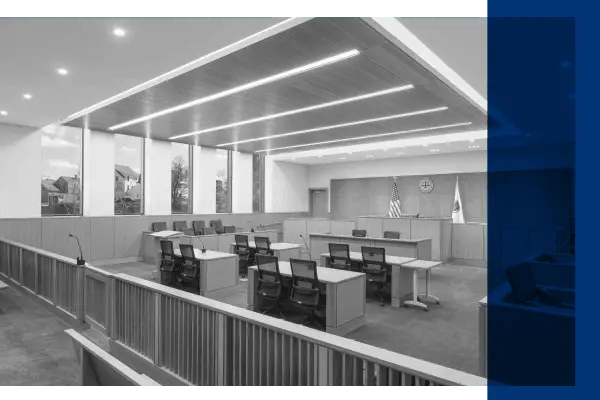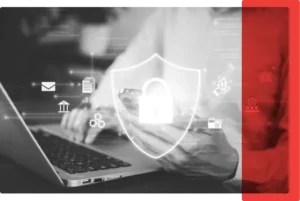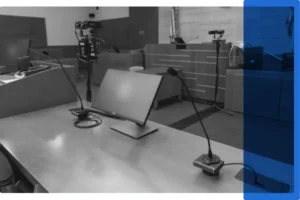
23 Dec
2021
2021 court technology trends: How ‘disruption by design’ is future-proofing courts against the unpredictable
Innovative technological solutions for courts are underpinned by the concept of ‘disruption by design’––intentional and positive disruptions of traditional methods of administering justice for the benefit of all, in the face of unpredictable societal disruptions.
Today, we are looking at the major trends in court technology that we have seen––and enabled––throughout the year.
Predictability and reliability in technological solutions offer certainty in an uncertain world. Court users expect the technology they use to operate as expected and designed every day. This is why For The Record is committed to supporting court jurisdictions in the implementation of these digital innovations, providing a high level of engagement, education, and ongoing training to ensure these solutions are fit-for-purpose and operate as meticulously designed and expected.
Undoubtedly, technology cannot solve every problem facing the justice system––but if it operates as expected, it can enhance the justice system to be more resilient, responsive, flexible, and accessible so courts can better serve court users.
The pandemic has been an unprecedented and tragic event affecting everyone around the world. When it comes to courts, however, it has been a necessary catalyst towards modern justice. The system is transforming to a fairer and more efficient model for all stakeholders––judiciary, attorneys, court administration, court participants, and the public alike.
Here are some trends in court technology that have evolved throughout 2021.
Greater appetite for innovation
Throughout the pandemic, we have partnered with numerous jurisdictions to support their efforts to modernize operations, with courts taking advantage of cloud-based solutions and other technologies that incorporate flexibility, scalability, and efficiencies into existing processes.
Other courts that initially resisted, or implemented interim measures, are now faced with the task of investigating how they can transform to reduce case backlogs, increase efficiencies, meet citizen and constitutional expectations and requirements, and implement future-proof solutions. The appetite to implement these changes is increasing as the benefits of an enhanced digital approach become more evident.
Use of AI in the courtroom
AI algorithms and engines that underpin applications like Speech-to-Text are not here to replace lawyers, judiciary, or court reporters, but to support and equip them with the tools required to either automate daily repetitive tasks or even expedite existing processes. This includes providing immediate access to searchable text synced with time-stamped audio and video recordings of proceedings.
The result is a significant reduction in costs and time, plus an increased focus on specialized tasks, including reviewing testimony in court or revising trial strategies
Increased digitization of court processes
The modernization of justice administration requires the integration of improvements to existing laborious processes with fit-for-purpose, carefully considered technological tools.
With the digitization of processes including, but not limited to, e-filing evidence uploads, digital case management, court calendar scheduling, and court recording, court users are able to navigate and manage a variety of workflows with greater ease and efficiency than ever before.
Digital platforms and tools are continuing to demonstrate the potential to solve the problems facing courts. Transcript Express has reformed outdated delivery of court recordings and transcripts, streamlining the manual and time-consuming processes involved in locating, managing, ordering, distributing, and archiving court recordings and transcripts.
Similarly, with jurisdictions around the world turning to video conferencing technology to keep courts accessible, Digital Justice has brought participants together safely from their homes, chambers or offices, with courts dialing in a virtual recorder to capture hearings outside traditional session hours and across multiple jurisdictions.
From streamlined online transcript management, ordering, and payments to the increasing prevalence of remote hearings, more court systems are adopting new ways to increase access to justice.
Shoring up the security of the court record
In February 2021, the 111-year-old Mason County courthouse in Texas was burned to the ground. Amid the ashes, very little remained of the historic timber and sandstone structure, which was allegedly set alight by a local man upset by a case in which he’d been involved.
The court records, however, were spared since the courthouse operations—including the court records—had already been relocated to a separate building ahead of renovation works. What could seem like fortuitous timing should, though, stand as a reminder of the vulnerability of the court record—particularly if the court record is stored physically in paper files or on local servers.
Providing a secure and accurate court record is a fundamental tenet of a fair and transparent justice system, and can now be achieved more readily than ever before with cloud technology. Recording Vault exponentially increases the ease and security of managing vital recordings by providing automatic, secure cloud-based storage and a comprehensive, centralized management platform accessible from anywhere.
Whether arson, a natural disaster, an extreme weather event, employee theft, or cyber-crime, threats to the court record are manageable and largely preventable with cloud technology and cyber security measures.
What’s next for courts
Jurisdictions around the world have received an invaluable opportunity to reshape how justice is managed, administered, and accessed––both in their courtrooms and remotely.
Technological solutions with inherent capacity to improve the court’s operations, performance, and ability to address complex and multi-faceted justice problems now and in the future have been implemented in a relatively small number of innovative courts.
As more courts investigate, adopt, and integrate these solutions with streamlined processes and comprehensive support services for court users, access to justice will expand and courts will be better equipped to deal with the everyday demands on the justice system and unpredictable societal disruptions.



